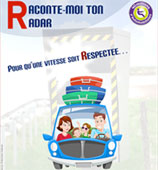5/1/2013
France: Report Identifies Most Outrageous Speed TrapsMotorist group in France compiles list of the worst speed traps based on input from 67,000 drivers.

Motorists in France are arming themselves against what they consider predatory speed traps. The pro-driving group Forty Million Motorists on Monday released a 32-page report detailing the country's most underhanded speed camera locations. The group compiled the list by sorting through the 67,000 results they received after asking the public to, "Tell me about your radar."
"Every trap is a counter-productive in terms of acceptance of road safety policy," the report explained. "That is why we hope that the selected stories will alert public authorities to the inconsistent and tricky situations motorists identified."
The report classified the testimony they collected under ten general types of speed trap. The first, as represented by the camera on the D338 between Tours and Le Mans, relies upon inconsistency. One side of the road has a 90km/h speed limit (55 MPH) the other side has a 70km/h (43 MPH) limit -- only the 70km/h side has a speed camera.
The second type of trap is a camera placed where the speed limit is not appropriate. French motorists complained about cameras being stationed on four-lane, pedestrian free, well maintained highway with a limit of just 50km/h (31 MPH). The third trap is the camera stationed at the bottom of a downhill road, designed to entrap drivers as their speed increases slightly over the limit due to gravity.
Fourth is the hidden camera, where officials place the device behind bushes or other obstructions in a deliberate attempt to surprise motorists. Fifth is a photo radar unit placed inside a zone where the speed limit briefly lowers. French drivers complained that these devices were not targeting outrageous speeders, but going after honest drivers who may have missed the speed limit sign. Sixth is a similar situation where a camera is placed in a speed zone that is suddenly lowered, as the camera at Saint Avertin where motorists were used to driving legally at 100km/h (62 MPH), and the same speed a few days later resulted in a ticket. This happened to be the most profitable camera of 2012.
Seventh is confusing or insufficient signage. Cameras are often placed in locations where the speed limit sign is too far from the camera so motorists do not know how fast they should be driving. Eighth is the camera placed after, not before, known road hazards. Ninth is the camera in a passing zone, which tells motorists to focus on their speedometer rather than overtaking in the safest manner possible. The last type is the entry and exit points of a town where cameras are placed nowhere near homes on entry or right before the lowered speed limit ends upon exit.
The report recommends placing speed limit signs at the speed camera site, a national audit of cameras and their locations, clear rules on when lowering the speed limit is permissible and outlawing hidden speed cameras.
A copy of the report is available (in French) in a 1.5mb PDF file at the source link below.


